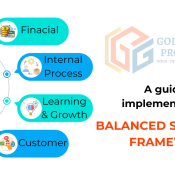
The Operational Strategy: Making It Work For Your Organization (Part 2)
Alignment across the organisation
It’s a people-first approach. When it comes to your operational plan, it’s critical that everyone in your organisation is on the same page. Different departments and personnel may have competing objectives or strive towards competing goals if they are not aligned. This might squander resources and make it difficult to attain your goal. If your employees do not comprehend the relationship between the purpose and vision, they may find themselves swimming against the flow.
Competencies Fundamentals
An operational plan assesses your company’s primary strengths and takes into account the resources available. A strategy map will assist you in connecting your operational priorities to your KPIs and objectives. Your employees must understand the link between their acts and the broader picture.
Customer-driven
Your consumers have high expectations for everything from the product to the user experience to the support and aftercare. You can provide a better experience for everyone if you have a fundamentally human approach that focuses on the needs of people—your workers and consumers.
Priorities for competitive advantage
An operational strategy is essential for staying ahead of the competition and being competitive in the market. You can guarantee that your organisation is producing goods and services at the lowest possible cost, meeting or surpassing customer expectations, responding swiftly to customer requests, and adjusting to market changes by concentrating on key criteria such as cost, quality, speed, and flexibility.
Digitally capable
Spreadsheets are no longer used to manage people and processes. With a plan that is easier to access, comprehend, and implement, digital transformation allows you to envision the future. Our GOLDEN GATE PROPERTIES strategy execution team will be a great support for your operations managers and teams eager to put their ideas into action.
Encourages cooperation
Human resources are the most precious resource, notwithstanding the cliché. When you offer your front-line staff a say in your strategy, you may benefit from their first-hand client experience. This collaborative approach to operations strategy creation will focus your strategic plans and improve ground-level execution.
What is an example of a business strategy?
If you are the operations manager of a clothing manufacturing company, and you want to optimise profitability by boosting efficiency and lowering expenses. To do this, you must develop an operational plan that prioritises cost reduction, quality control, speed, and flexibility. To do this, you must connect your operations plan with your overall company strategy, split it into major focus areas, identify targets and associated projects, and track success using key performance indicators (KPIs).
Alignment of operational plans and KPI progress
In the cost reduction target area, for example, you may establish a goal of reducing raw material costs by 10% over the next six months and undertake projects like negotiating lower rates with suppliers, improving your supply chain, and adopting an inventory management system. Indicators such as supplier cost per unit and inventory turnover can be used to track success.
Similarly, in the quality control emphasis area, you may establish a goal of improving product quality by 15% over the next six months and undertake projects like investing in new technology, creating efficient processes, and implementing a quality control programme. KPIs such as product failure rate and customer satisfaction can be used to track performance.
By implementing this operational strategy and dividing it into key focus areas, defining objectives and related projects, and measuring performance using KPIs, your company will be able to produce more efficiently, reduce costs, and improve quality control, allowing you to meet your business goals and objectives while also aligning with the overall corporate strategy
The most important success variables for operations strategy
In operations strategies, there is a pattern to success. These four factors contribute to a company’s buy-in and progress.
Team alignment
While developing your operations plan, ensure that your team is aligned with your overarching mission and strategy map. Individual objectives, team objectives, and project benchmarking all interact as everyone pulls in the same direction.
Employee engagement
An operational plan that does not engage its personnel from the start will not endure long. A top-down strategy in which the C-suite dictates ideas from their high horses outside the boardroom is not the way to win your organization’s hearts and minds.
An omnidirectional model is more successful because it makes individuals feel important. What’s more, guess what? They are significant! You are only as good as the people on your team. Working closely with employees on strategy development and taking into account their thoughts, contentment, and individual objectives will result in a far better conclusion.
Innovative practices
A successful operations strategy develops a culture that is always looking for ways to improve. When you accept creative new methods, you promote business development by keeping your organisation quick and adaptable, ready to adjust to market changes.
New tools and automation practises can help you improve aspects of your business, connect employees, and operate more efficiently in all areas. Explosive growth is unavoidable when growth and innovation are central to your operations strategy.
Data-driven evolution
Data reveals where your plan succeeds and where it fails. Data may be used to identify opportunities to offer value and embrace change. You may assess success measures and make adjustments based on feedback, resulting in more accurate forecasts and wiser operational decisions. You may start dreaming larger and executing better with data-driven iterative techniques.
Strat executing your operations strategy
High-level operations strategies serve as the framework for successful business practices on the ground. Whether you want to rob a casino, conquer the planet, or improve your product development and production activities, a well-designed operations strategy is a crucial instrument for driving game-changing innovation and success.
It is the single source of truth that your team requires to bridge the gap between planning and execution.
Once established, your entire firm can concentrate on what is important. It is the best technique to empower your employees and encourage them to take the necessary steps to make your vision a reality.
GOLDEN GATE PROPERTIES can assist you in disrupting the way you do strategy in order to adapt your approach at each level. To get started, TALK TO US
Questions about operational strategies that are frequently asked
What is the significance of operational strategy?
An operational strategy is important because it allows a company’s resources and activities to be aligned with its overall business strategy. It also assists a firm in remaining competitive by finding chances for improvement and cost savings, as well as ensuring that the organisation is able to adapt rapidly to market developments. It is also an important part of strategic operations management since it aids in the development of a strategy to fulfil the company’s goals and objectives.
What are the four competitive priorities in a business strategy?
An operational strategy’s four competitive priorities are cost, quality, speed, and adaptability.
Cost competitiveness refers to the ability to produce goods and services at a lower cost than competitors.
Quality competitiveness refers to the ability to produce goods and services that meet or exceed customer expectations.
Speed competitiveness refers to the ability to quickly respond to customer needs and get products to market faster than competitors.
Flexibility competitiveness refers to the ability to quickly adapt to changes in customer demands or market conditions.
Achieving a balance among these priorities is important as it allows a company to meet the needs of customers and stay competitive in the market. This means that, a company should aim to produce goods and services at the lowest possible cost while maintaining a high level of quality, respond quickly to customers’ needs and adapt to market changes.
How does an operational strategy relate to a company’s overall business strategy?
An operational strategy is a component of a company’s overall business strategy. It outlines how the company will use its resources to achieve its goals and objectives. The operational strategy should support and align with the company’s overall business strategy by addressing how the company will produce and deliver goods and services to customers. It is also a key aspect of corporate strategy and supply chain management.
How do you measure the success of an operational strategy?
Measuring the success of operational strategies can be done by monitoring key performance indicators (KPIs) such as cost, quality, speed, and flexibility. Additionally, companies can track other metrics such as production capacity, inventory turnover, and customer satisfaction to evaluate the effectiveness of their operational strategy. It’s important to regularly review and adjust the operational strategy based on the performance data. An operations manager can also use SWOT analysis to evaluate the company’s strengths and weaknesses, opportunities and threats to ensure the success of the strategy.



